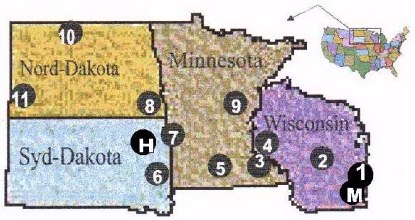

 people began to emigrate from Holla to America from the beginning of 1840. In the years preceding 1900 about 1100 people emigrated from Holla - probably more. Some of those who left had more of a pioneering spirit than others! From Martin Ulvestad's book "Nordmændene i Amerika" (Norwegians in America) we can see that many people from Holla were the first to settle new ground in the West of America.
people began to emigrate from Holla to America from the beginning of 1840. In the years preceding 1900 about 1100 people emigrated from Holla - probably more. Some of those who left had more of a pioneering spirit than others! From Martin Ulvestad's book "Nordmændene i Amerika" (Norwegians in America) we can see that many people from Holla were the first to settle new ground in the West of America.
Congregation
|
Beg./Stop
|
Town or
|
distance to town
|
County
|
State
|
Comments:
|
1843 - 1890
1848 -1910
-
-
1854 -
1856 -
1864 -
1874 -1879
1879 -1896
1885 -
1895 -1897
1895-
1901-?
1908-?
1880 -
|
-
-
St.James 1)
Sinai 2)
Geneseo 3)
|
4 miles N
-
-
-
-
7 miles N.Ø. (N.E.)
-
13 miles S.W.
1 mile S
5 miles S.
6 miles S.W.
7 miles N.W.
6 miles Ø. (E.)
12 miles N.W.
6½ miles S.Ø. (S.E
|
Waukesha
Ozonkee
Walworth
------ " ------
Waushara
Goodhue
Dunn
Watonwan
Brookings
Big Stone
Sargent
Aitkin
Bottineau
Slope
Codington
|
WI
WI
WI
WI
WI
MN
WI
MN
SD
MN
ND
MN
ND
ND
SD
|
1) From 1874 -1886 in LOM, whitch from 1886 merged with LONG LAKE congregation.
2) Merged with BLOM in 1896 and formed LAKE SINAI congregation.
3) In 1897 the name was changed to BERGEN congregation.
|
 The table shows that naturally enough the development of the churches follows to a large degree the pattern of immigration from the East towards the West of America. As far as I can see there are two reasons that the name `Holden' was chosen. The first is that emigrants from Holden/Holla named the new churches after the one they left behind, and this is the most likely explanation for the naming of most `Holden' congregations. Another possible explanation is that people who settled first in a `Holden' in America and then moved on to settle new ground took the name with them, despite the fact that they had no connection with Holden in Norway. Before we take a closer look at these congregations we first visit Muskego, where the first Norwegian church in America was built.
The table shows that naturally enough the development of the churches follows to a large degree the pattern of immigration from the East towards the West of America. As far as I can see there are two reasons that the name `Holden' was chosen. The first is that emigrants from Holden/Holla named the new churches after the one they left behind, and this is the most likely explanation for the naming of most `Holden' congregations. Another possible explanation is that people who settled first in a `Holden' in America and then moved on to settle new ground took the name with them, despite the fact that they had no connection with Holden in Norway. Before we take a closer look at these congregations we first visit Muskego, where the first Norwegian church in America was built.